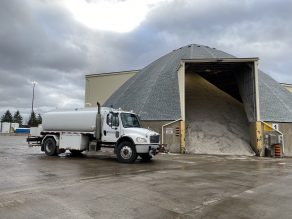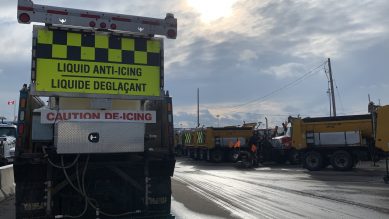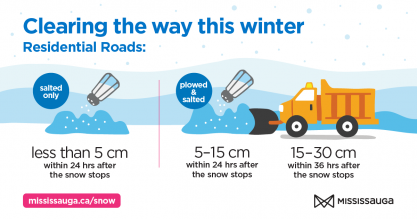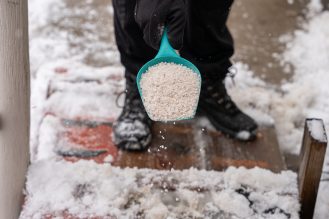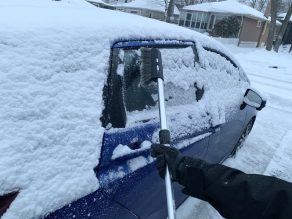Safe not salty: How the City controls its winter salt use
City services | January 4, 2024
Snowfall, cold temperatures and freezing rain can quickly lead to hazardous conditions on roads and infrastructure, like sidewalks, trails and bridges. By pre-treating, plowing and salting in the right way, at the right place, at the right time, the City is maintaining road safety while limiting the impact of salt on the environment.
Across Mississauga, more than 51,000 stormwater storm drains and 1,900 kilometres of pipes help to drain rain and melted snow from roads and properties into local waterways and eventually Lake Ontario. Unfortunately, runoff from melting snow and ice can also pick up materials like soap, oil, litter, chemicals and salt which can be harmful to aquatic plants and wildlife.
Here’s what the City is doing, and what you can do, to manage salt-use and minimize its environmental impacts this winter.
Effective salt management at the City
Pre-treating roads with brine
The City is using more brine equipment to help limit its use of rock salt. A liquid brine solution, which is 23 per cent saltwater, is applied to roads and bridges before a snowfall or freezing rain. It helps break the bond between the precipitation (i.e. snow and rain) and the road, which prevents ice from forming and snow from sticking to the road. Less rain and snow freezing to the roads means less salt is needed to keep the roads safe. It also makes plowing easier and more efficient.
Plowing more often
The City plows when snowfall reaches five centimetres of accumulation. Plowing more frequently means less salt is needed and makes salt more effective when applied. Applying salt to snow-covered streets and infrastructure reduces the effectiveness of the salt – creating a waste of material and salty runoff. When snow is cleared during a snowstorm and soon after the snow stops, this helps to avoid ice buildup and creates better conditions for the salt to work.
Using advanced weather monitoring and equipment
Using advanced weather monitoring technology, the City knows when and where is the best time to pre-treat, salt or plow the roads. One of these tools is the temperature gauge on trucks that let staff know the temperature of the road. For example, when the road temperature is 0° Celsius or colder, staff know to brine the roads before a forecasted rainfall, because these conditions can lead to freezing rain. When the road temperature is 0° Celsius or colder and a snowfall is expected, staff can predict that plowing will be necessary because the snow will accumulate on the cold road.
Applying treated salt on colder days
The City uses specially treated salt (magnesium chloride) on roads, bus stops and priority sidewalks when the temperature drops below -7° Celsius. This treated salt works better at colder temperatures, so less of it is needed.
How you can help
When winter weather hits, we can all do our part to keep each other safe, support crews as they work and strategically manage our salt use.
- Clear snow off your sidewalk and driveway soon after the snow stops to avoid ice buildup.
- When melted snow and ice re-freezes it can cause slippery and hazardous conditions. Make sure your downspouts direct the water onto your lawn, away from your sidewalk and driveway.
- Try to pile snow where it won’t melt onto your sidewalk and driveway.
- Always remove snow before applying ice-melting and anti-skid materials as recommended by the manufacturer to minimize the impact on the environment. It only takes one to two cups of salt to cover a single-car driveway
- Salt only works on ice and snow when the temperature is above -10°Celsius. Use alternatives like sand, grit, mulch, non-clumping kitty litter or treated salt (magnesium chloride) to add traction when the temperature is below -7° Celsius. Some of these options can even be swept up and reused.
- When safe to do so, clear ice and snow from storm drains to allow water to drain safely and prevent ice buildup on the road. Call 311 to report blocked storm drains.
- If you see over-salting at one of our MiWay bus stops, report it to 311.
Additional winter safety tips
Consider taking the following actions to ensure your safety and the safety of others:
- Remove snow and ice off your vehicle, including all windows, headlights, roof and hood, before you leave
- Allow extra time when travelling
- Give snowplows, salt trucks and other snow-clearing equipment space to work
- Drive according to weather and road conditions
- Wear appropriate footwear to avoid slips and falls
- Bring pets indoors during extreme weather condition
- Install winter tires for better traction
Stay up-to-date on snow clearing in Mississauga:
- Visit mississauga.ca/snow to learn more about snow clearing in the city
- Follow @MississaugaSnow on X for snow-clearing updates
- Call 311 (905-615-4311 if outside city limits) to report a missed street clearing after the level of service timelines have ended
- Follow @PeelPublicWorks for snow-clearing updates on Regional roads
Background
The City is responsible for clearing snow and ice on City-owned infrastructure, including 5,700 lane kilometres of roads, 1,700 lane kilometres of priority sidewalks, 3,300 bus stops, more than 1,000 pedestrian crossings, 68 kilometres of on-street bike lanes and 127 kilometres of roadside multi-use trails. City staff also provide winter maintenance at City facilities including community centres, libraries, and some park parking lots, paved pathways and trails.
Peel Region is responsible for clearing most regional roads in Mississauga, which are main roads with higher speeds and more traffic than local residential roads.
Tags
Media contact
City of Mississauga Media Relations
media@mississauga.ca
905-615-3200, ext. 5232
TTY: 905-896-5151
